《动物免疫学》课程PPT教学课件(讲稿)B细胞的生物学(Biology of the B Lymphocyte)
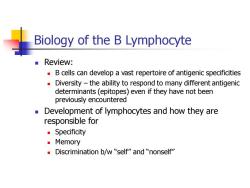
Biology of the B Lymphocyte Review: .B cells can develop a vast repertoire of antigenic specificities Diversity-the ability to respond to many different antigenic determinants(epitopes)even if they have not been previously encountered Development of lymphocytes and how they are responsible for ·Specificity Memory Discrimination b/w "self"and "nonself
Biology of the B Lymphocyte ◼ Review: ◼ B cells can develop a vast repertoire of antigenic specificities ◼ Diversity – the ability to respond to many different antigenic determinants (epitopes) even if they have not been previously encountered ◼ Development of lymphocytes and how they are responsible for ◼ Specificity ◼ Memory ◼ Discrimination b/w “self” and “nonself
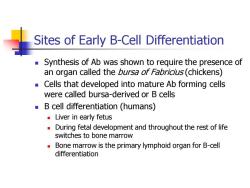
Sites of Early B-Cell Differentiation Synthesis of Ab was shown to require the presence of an organ called the bursa of Fabricius(chickens) Cells that developed into mature Ab forming cells were called bursa-derived or B cells B cell differentiation (humans) Liver in early fetus During fetal development and throughout the rest of life switches to bone marrow Bone marrow is the primary lymphoid organ for B-cell differentiation
Sites of Early B-Cell Differentiation ◼ Synthesis of Ab was shown to require the presence of an organ called the bursa of Fabricius (chickens) ◼ Cells that developed into mature Ab forming cells were called bursa-derived or B cells ◼ B cell differentiation (humans) ◼ Liver in early fetus ◼ During fetal development and throughout the rest of life switches to bone marrow ◼ Bone marrow is the primary lymphoid organ for B-cell differentiation
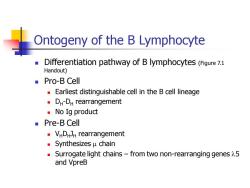
Ontogeny of the B Lymphocyte Differentiation pathway of B lymphocytes(Figure 7.1 Handout) Pro-B Cell Earliest distinguishable cell in the B cell lineage ·DH-DH rearrangement ·No Ig product ■Pre-B Cell ·VHDHJH rearrangement Synthesizes u chain Surrogate light chains-from two non-rearranging genes 5 and VpreB
Ontogeny of the B Lymphocyte ◼ Differentiation pathway of B lymphocytes (Figure 7.1 Handout) ◼ Pro-B Cell ◼ Earliest distinguishable cell in the B cell lineage ◼ DH-DH rearrangement ◼ No Ig product ◼ Pre-B Cell ◼ VHDHJH rearrangement ◼ Synthesizes m chain ◼ Surrogate light chains – from two non-rearranging genes l5 and VpreB
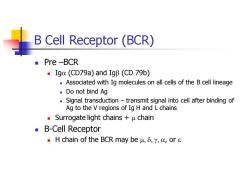
B Cell Receptor (BCR) ■Pre-BCR Iga(CD79a)and IgB(CD 79b) Associated with Ig molecules on all cells of the B cell lineage Do not bind Ag Signal transduction-transmit signal into cell after binding of Ag to the v regions of Ig H and L chains Surrogate light chains +u chain B-Cell Receptor ,H chain of the BCR may be p,δ,Y,,ore
B Cell Receptor (BCR) ◼ Pre –BCR ◼ Iga (CD79a) and Igb (CD 79b) ◼ Associated with Ig molecules on all cells of the B cell lineage ◼ Do not bind Ag ◼ Signal transduction – transmit signal into cell after binding of Ag to the V regions of Ig H and L chains ◼ Surrogate light chains + m chain ◼ B-Cell Receptor ◼ H chain of the BCR may be m, d, g, a, or e

B Cell Ontogeny Cells that do not express pre-BCR die by apoptosis Cells expressing pre-BCR undergo "positive selection" Signals via the pre-BCR induce cells to proliferate Surrogate light chain synthesis is shut down Light chain rearrangement starts Further H chain rearrangement is stopped Immature B Cells Light chains pair with m chains(membrane-bound monomeric form) Immature B cells can recognize and respond to foreign Ag, but this interaction results in long-lasting inactivation rather than expansion and differentiation
B Cell Ontogeny ◼ Cells that do not express pre-BCR die by apoptosis ◼ Cells expressing pre-BCR undergo “positive selection” ◼ Signals via the pre-BCR induce cells to proliferate ◼ Surrogate light chain synthesis is shut down ◼ Light chain rearrangement starts ◼ Further H chain rearrangement is stopped ◼ Immature B Cells ◼ Light chains pair with m chains (membrane-bound monomeric form) ◼ Immature B cells can recognize and respond to foreign Ag, but this interaction results in long-lasting inactivation rather than expansion and differentiation
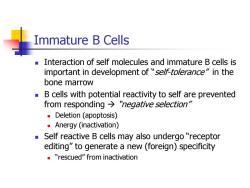
Immature B Cells Interaction of self molecules and immature B cells is important in development of "se/f-tolerance"in the bone marrow B cells with potential reactivity to self are prevented from responding "negative selection" Deletion (apoptosis) Anergy (inactivation) Self reactive B cells may also undergo receptor editing"to generate a new(foreign)specificity "rescued"from inactivation
Immature B Cells ◼ Interaction of self molecules and immature B cells is important in development of “self-tolerance” in the bone marrow ◼ B cells with potential reactivity to self are prevented from responding → “negative selection” ◼ Deletion (apoptosis) ◼ Anergy (inactivation) ◼ Self reactive B cells may also undergo “receptor editing” to generate a new (foreign) specificity ◼ “rescued” from inactivation
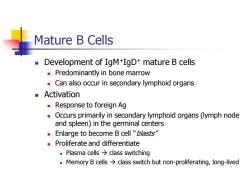
Mature B Cells Development of IgM+IgD+mature B cells Predominantly in bone marrow Can also occur in secondary lymphoid organs ■Activation Response to foreign Ag Occurs primarily in secondary lymphoid organs(lymph node and spleen)in the germinal centers Enlarge to become B cell "blasts" Proliferate and differentiate Plasma cells>class switching Memory B cells>class switch but non-proliferating,long-lived
Mature B Cells ◼ Development of IgM+IgD+ mature B cells ◼ Predominantly in bone marrow ◼ Can also occur in secondary lymphoid organs ◼ Activation ◼ Response to foreign Ag ◼ Occurs primarily in secondary lymphoid organs (lymph node and spleen) in the germinal centers ◼ Enlarge to become B cell “blasts” ◼ Proliferate and differentiate ◼ Plasma cells → class switching ◼ Memory B cells → class switch but non-proliferating, long-lived

Memory B Cells Generation is associated with class switch and somatic hypermutation in the germinal centers of spleen and lymph node Germinal centers provide an environment where B cells with mutations for high affinity for Ag are clonally selected and expanded Serve as memory cells for subsequent responses Affinity maturation increases the production of high affinity Ab in the secondary response
Memory B Cells ◼ Generation is associated with class switch and somatic hypermutation in the germinal centers of spleen and lymph node ◼ Germinal centers provide an environment where B cells with mutations for high affinity for Ag are clonally selected and expanded ◼ Serve as memory cells for subsequent responses ◼ Affinity maturation increases the production of high affinity Ab in the secondary response
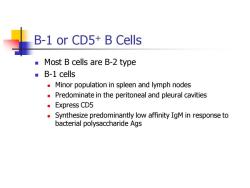
B-1 or CD5+B Cells Most B cells are B-2 type ■B-1 cells Minor population in spleen and lymph nodes Predominate in the peritoneal and pleural cavities ·Express CD5 Synthesize predominantly low affinity IgM in response to bacterial polysaccharide Ags
B-1 or CD5+ B Cells ◼ Most B cells are B-2 type ◼ B-1 cells ◼ Minor population in spleen and lymph nodes ◼ Predominate in the peritoneal and pleural cavities ◼ Express CD5 ◼ Synthesize predominantly low affinity IgM in response to bacterial polysaccharide Ags
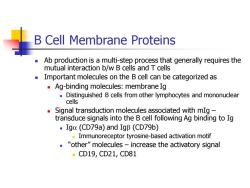
B Cell Membrane Proteins Ab production is a multi-step process that generally requires the mutual interaction b/w B cells and T cells Important molecules on the B cell can be categorized as Ag-binding molecules:membrane Ig Distinguished B cells from other lymphocytes and mononuclear cells Signal transduction molecules associated with mIg- transduce signals into the B cell following Ag binding to Ig Iga(CD79a)and IgB(CD79b) Immunoreceptor tyrosine-based activation motif "other"molecules-increase the activatory signal ·CD19,CD21,CD81
B Cell Membrane Proteins ◼ Ab production is a multi-step process that generally requires the mutual interaction b/w B cells and T cells ◼ Important molecules on the B cell can be categorized as ◼ Ag-binding molecules: membrane Ig ◼ Distinguished B cells from other lymphocytes and mononuclear cells ◼ Signal transduction molecules associated with mIg – transduce signals into the B cell following Ag binding to Ig ◼ Iga (CD79a) and Igb (CD79b) ◼ Immunoreceptor tyrosine-based activation motif ◼ “other” molecules – increase the activatory signal ◼ CD19, CD21, CD81
按次数下载不扣除下载券;
注册用户24小时内重复下载只扣除一次;
顺序:VIP每日次数-->可用次数-->下载券;
- 《动物免疫学》课程PPT教学课件(讲稿)B细胞对抗原的识别和应答.ppt
- 《动物免疫学》课程PPT教学课件(讲稿)Antigen Recognition.ppt
- 《动物免疫学》课程PPT教学课件(讲稿)Antibody-Antigen Reactions.ppt
- 《动物免疫学》课程教学资源(文献资料)补体 Complement(英文)1.pdf
- 《动物免疫学》课程教学资源(文献资料)补体 Complement(英文)2.pdf
- 《动物免疫学》课程教学资源(文献资料)补体调节蛋白(英文).pdf
- 《动物免疫学》课程教学资源(文献资料)补体缺陷性疾病(英文).pdf
- 《动物免疫学》课程教学资源(文献资料)补体的检测法(英文).pdf
- 《动物免疫学》课程教学资源(文献资料)补体激活的经典途径(英文).pdf
- 《动物免疫学》课程教学资源(文献资料)补体激活的末端途径(英文).pdf
- 《动物免疫学》课程教学资源(文献资料)补体激活的旁路途径(英文).pdf
- 《动物免疫学》课程教学资源(文献资料)补体受体(英文).pdf
- 《动物免疫学》课程教学资源(文献资料)抗微生物蛋白和肽(英文).pdf
- 《动物免疫学》课程教学资源(文献资料)抗原递呈给淋巴细胞(英文).pdf
- 《动物免疫学》课程教学资源(文献资料)抗原被淋巴细胞识别(英文).pdf
- 《动物免疫学》课程教学资源(文献资料)抗原抗体结合(英文).pdf
- 《动物免疫学》课程教学资源(文献资料)抗原处理过程(英文).pdf
- 《动物免疫学》课程教学资源(文献资料)抗体(英文).pdf
- 《动物免疫学》课程教学资源(文献资料)免疫系统的细胞(英文).pdf
- 《动物免疫学》课程教学资源(文献资料)免疫应答(英文).pdf
- 《动物免疫学》课程PPT教学课件(讲稿)细胞因子 Cytokines.ppt
- 《动物免疫学》课程PPT教学课件(讲稿)IL-8生物活性的检测.ppt
- 《动物免疫学》课程PPT教学课件(讲稿)Cellular Cooperation and Antigen Recognition.ppt
- 《动物免疫学》课程PPT教学课件(讲稿)T淋巴细胞与特异性细胞免疫.ppt
- 《动物免疫学》课程PPT教学课件(讲稿)主要的补体系统缺乏(Primary deficiencies of the complement system).ppt
- 《动物免疫学》课程PPT教学课件(讲稿)主要组织相容性复合体及其编码分子.ppt
- 《动物免疫学》课程PPT教学课件(讲稿)主要组织相容性抗原系统(histicompatibility antigen).ppt
- 《动物免疫学》课程PPT教学课件(讲稿)传染与免疫(病原体对机体的感染、机体对感染的预防和治疗).ppt
- 《动物免疫学》课程PPT教学课件(讲稿)体液免疫反应 Humoral Immune Response.ppt
- 《动物免疫学》课程PPT教学课件(讲稿)免疫学发展简史及展望.ppt
- 《动物免疫学》课程PPT教学课件(讲稿)免疫学概论.ppt
- 《动物免疫学》课程PPT教学课件(讲稿)免疫应答概述(Immune response).ppt
- 《动物免疫学》课程PPT教学课件(讲稿)免疫标记技术及应用.ppt
- 《动物免疫学》课程PPT教学课件(讲稿)免疫球蛋白(Immunoglobulin, Ig).ppt
- 《动物免疫学》课程PPT教学课件(讲稿)免疫系统(The Immune System).ppt
- 《动物免疫学》课程PPT教学课件(讲稿)免疫系统的遗传学(Genetics of the Immune system).ppt
- 《动物免疫学》课程PPT教学课件(讲稿)免疫耐受 Immunological Tolerance.ppt
- 《动物免疫学》课程PPT教学课件(讲稿)免疫自动化仪器分析.ppt
- 《动物免疫学》课程PPT教学课件(讲稿)抗原(Antigen, Ag).ppt
- 《动物免疫学》课程PPT教学课件(讲稿)抗体-抗原反应(Antibody-Antigen Reactions).ppt
